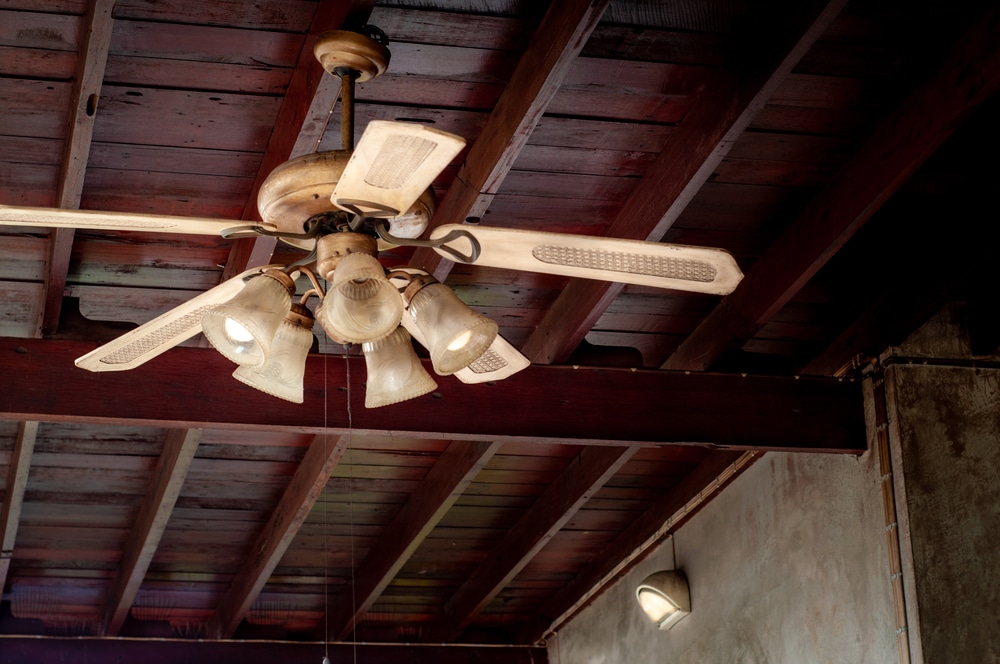Last Updated on
A squeaky ceiling fan is annoying. Unfortunately, fans can tend to make a strange sound from time to time. That constant noise may drive anybody insane, but there’s no need for you to continue to suffer.
Instead, there’s an easy option, and it’s also a quick job to do when repairing your ceiling fan. Another bonus is it’s also inexpensive. As long as you have the correct tools, there’s no need to get expert help to come and help you with your fan.
So, what is this easy option we speak of? It’s by using oil. It’s as simple as that.
Well, almost as simple as that. You see, there are a few steps that you must go through to correctly oil ceiling fans. But that’s where we will show you how to oil a squeaky ceiling fan quickly and effortlessly.
What Causes a Ceiling Fan to Squeak?
Before we get you to fix your fan, let’s look at why it’s squeaking in the first place.
Dust and Dirt
The problem with a ceiling fan is that dust and dirt in the room may gain access to the fan blades and the inner workings of the fan. The motor can have a build-up of dust, and that means things won’t run as smoothly as they should.
Of course, we are guilty of simply giving our ceiling fan a quick dusting and presuming that’s everything. We look at the fan blades and how they appear clean, but then we move on. We don’t think about the different pieces that make up the fan and how it functions, and that’s where the problem arises. In short, it’s generally dust and dirt causing the squeaking, but cleaning isn’t the only solution.
Loose Screws
Dust and dirt are not the only causes of a squeaky ceiling fan. Over time, the screws that hold both the fan to the ceiling and the blades to the fan motor can become loose. It can lead to that familiar squeaking sound being produced.
Ceiling Fan Maintenance
Dust and dirt have the ability to effectively grind down the movement of the various parts of your ceiling fan. The different aspects of the motor cannot work as well since the dust is causing an obstruction. It causes parts of the motor and fan blades to seize up slowly.
Using the correct oil reverses that problem. The lubrication gets the motor working once more, and it will save you a fortune since there’s no need to go and replace the entire fan. Just a couple of drops of oil will be enough. So, how do you do it?
Step 1: Turn Off the Power
Safety first, and that means turning off the power to the fan. We would recommend turning off the power to the room and not just the fan itself. You can never be too careful when dealing with this sort of thing.
Check that the lighting in the room cannot work, as this is the perfect test to show that the power has been cut off before you begin. Do this before you even get your ladder out.
Step 2: Begin By Cleaning
You must begin by cleaning your ceiling fan. There’s no point adding oil as a lubricant on top of the grime and dust that’s still sitting there.
The best approach is to set up your ladder, use a damp cloth, and wipe away all the dust, starting with the fan blades. You will be surprised at how much dust accumulates on a single blade.
After this initial cleaning, check to make sure that all dust and grime have gone. You want this to be as spotless as possible, or you will be going through the whole process again in next to no time.
However, be gentle with the fan blade. Some versions are more fragile than others, and too much pressure could damage the blade’s tip. Also, don’t soak the blades. That’s why a damp cloth is best.
Step 3: Check For Wobbling Blades
After cleaning, check to see if the ceiling fan blades may need tightening. Do this by determining if the blades are wobbling as they rotate. This movement can cause the squeaky sound you have heard, especially when you turn up the fan’s speed.
If they do wobble, you need to tighten them, which is also easy to do.
Look for the screw that holds the particular blade onto the fan. Get the appropriate screwdriver, which is mostly a Phillips, and tighten the screw. After you have finished, recheck the blade to see if it’s more secure.
Step 4: Check the Fan Ceiling Mount
After checking the blades, you need to also check the ceiling mount for the fan. Making sure the fan is correctly attached to the ceiling is important, as the sounds you hear could be coming from the screws here becoming loose.
As with the blades, check each screw with your screwdriver, and tighten as necessary. Ideally, it should be done at least once a year. Although, it may vary depending on the ease of access.
Step 5: Check Lighting Options
Some ceiling fans have a light that comes with them. It is the final place to check in your fan. Something as simple as a slightly loose light bulb can cause a squeaky fan, so make sure everything is in place.
These steps are designed to help you deal with the squeak when it’s nothing to do with the motor. However, even though they may remove the noise, that’s not always the case. At that point, you have to move on, oiling the motor.
Oiling the Fan
But what happens if these various checks don’t solve the problem? Then it’s on to looking at the ceiling fan in more detail, and that’s what we will look at.
Step 1: Taking Apart the Fan
So dusting has not fixed the problem, so you then have to take apart the fan. Once again, check there are no live wires and turn off the power. Test that this is the case before proceeding.
Detach the blades, and loosen the screws to remove the central part of the fan. That’s where the motor is located. Once the fan is on the ground, carefully set each part aside since you will need to assemble the fan again once finished.
Step 2: Check the Key Components
We aren’t talking about taking the entire fan apart. Instead, you need to look for the bearings, as that’s where you need to apply the oil.
Remove the motor from the ceiling fan. It’s going to be located in the interior. Next, remove the bearings, and they will be easy to locate.
Set the bearings aside, and then get your oil.
Step 3: Lubricate the Bearings
When applying oil, you only need 2 or 3 drops. Add the lubricant to the bearing, and then spin the motor as this spreads the oil. Then, you need to add oil to the other side of the motor by using the same method.
Once again, rotate the motor, and this should be enough lubricant to help eliminate the squeak from your ceiling fan.
Step 4: Assemble the Fan
You then need to assemble the fan and begin by tightening up the motor and placing it back into the heart of the ceiling fan. Make sure to tighten each screw before moving onto the blades.
With the blades, check the screws are also tight before attaching the fan back to the ceiling.
Step 5: Testing
The final part will mean you need to test the fan. You want to be sure the blades are balanced and that there’s no sign of that squeak you once heard.
Test that each blade is secure, as it’s easy to under-tighten a fan blade, which would then lead to that noise starting all over again.
Your Ceiling Fan is Fixed
On most occasions, your ceiling fan is now fixed. If not, then double-check that it’s balanced and that any cover is correctly placed. Make sure the tip of each blade has not been damaged during assembly.
Finally, if the squeak persists after using oil to lubricate, then get professional advice. Don’t mess around with the wires if you have no experience with electrical devices. Also, don’t remove too many parts at once. You can easily become confused with the various components of ceiling fans.
Silence is Golden
It’s easy to learn how to oil a squeaky ceiling fan. Checking and maintaining your fan won’t take long. That squeaky sound should be gone if you follow our guide correctly. In no time at all, you’ll be able to enjoy your fan and the cool air it brings.
What kind of fan do you have at home? Have you had a squeaky fan? What caused the sound? How did you fix it? Tell us about it in the comments.
Paul is the type of person who never met a problem he couldn’t fix. He can always be found tinkering with something in his house, even if it isn’t broken! His tips and tricks are often shared on our site. He’s the one you call when something breaks because he has been known to improvise fixes for everything from leaky faucets to malfunctioning dryers.



